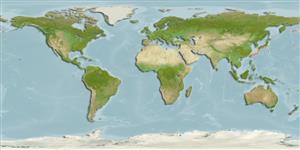>
Perciformes/Uranoscopoidei (Sand dwellers) >
Pinguipedidae (Sandperches)
Etymology: Parapercis: Greek, para = the side of + Greek, perke = perch (Ref. 45335); phenax: Name from a Greek word meaning imposter, refers to its resemblance to, and previous misidentification as, P. roseoviridis.
More on authors: Randall & Yamakawa.
Environment: milieu / climate zone / depth range / distribution range
Ecologie
marien bathydemersaal; diepte 322 - 600 m (Ref. 75889). Temperate
Northwest Pacific: Japan.
Grootte / Gewicht / Leeftijd
Maturity: Lm ? range ? - ? cm
Max length : 18.0 cm SL mannelijk / geslacht onbekend; (Ref. 75889); 14.7 cm SL (female)
Korte beschrijving
Determinatiesleutels | Morfologie | Morfometrie
Dorsale stekels (totaal) : 4 - 5; Dorsale zachte stralen (totaal) : 23 - 24; Anale stekels: 1; Anale zachte stralen: 19 - 20; Wervels: 31 - 33. This species is distinguished by the following characters: D IV-V (rarely IV); A I, 19-20 (usually 19); pectoral rays 19-20 (usually 19); lateral-line scales 60-64; gill rakers 4-7 + 10-13; canine teeth 3 pairs, anteriorly in lower jaw; palatine teeth present; body depth 5.0-5.95 in SL; head length 3.45-3.6 in SL; last 2 dorsal spines subequal, the last usually the longest, 3.8-4.15 in HL; last interspinous membrane of dorsal fin attached to the first dorsal soft ray nearly 1/2 length of ray from its base; caudal fin slightly rounded; pelvic fins reaching or extending slightly beyond anus, 1.25-1.55 in HL; body pink dorsally, lavender-white ventrally, with a series of 10 short dusky green to yellow bars on upper side of body (indistinct dorsally), the last 2 on caudal peduncle nearly merged; spinous portion of dorsal fin largely black in color (Ref. 75889).
Levenscyclus en paargedrag
Maturiteit | Voortplanting | Paaien | Eieren | Fecunditeit | Larven
Randall, J.E. and T. Yamakawa, 2006. Parapercis phenax from Japan and P. banoni from the Southeast Atlantic, new species of Pinguipedid fishes previously identified as P. roseoviridis. Zool. Stud. 45(1):1-10. (Ref. 75889)
Status op de Rode Lijst van het IUCN (Ref. 130435: Version 2024-1)
Gevaar voor de mens
Harmless
Gebruik door de mens
Tools
Speciale rapporten
Download XML
Internetbronnen
Estimates based on models
Preferred temperature (Ref.
123201): 10.4 - 14.7, mean 12.7 °C (based on 61 cells).
Fylogenetische diversiteitsindex (Ref.
82804): PD
50 = 0.5000 [Uniqueness, from 0.5 = low to 2.0 = high].
Bayesian length-weight: a=0.00692 (0.00314 - 0.01524), b=3.06 (2.88 - 3.24), in cm total length, based on LWR estimates for this Genus-body shape (Ref.
93245).
Trofisch niveau (Ref.
69278): 3.5 ±0.4 se; based on size and trophs of closest relatives
Weerstandsvermogen (Ref.
120179): Hoog, minimale populatieverdubbelingstijd minder dan 15 maanden (Preliminary K or Fecundity.).
Fishing Vulnerability (Ref.
59153): Low vulnerability (12 of 100).
